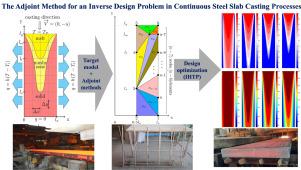连铸板坯反设计问题的伴随法
IF 6.4
2区 工程技术
Q1 MECHANICS
International Communications in Heat and Mass Transfer
Pub Date : 2025-09-27
DOI:10.1016/j.icheatmasstransfer.2025.109706
引用次数: 0
摘要
这项工作提出使用伴随方法,该工作的核心贡献,以解决在连铸钢坯过程中的逆向设计问题,旨在优化过程和降低计算成本,基于一种新的目标制造方法。该方法考虑了两组设计参数:(1)组一包括二冷区冷却喷嘴温度、冷却系统界面换热系数和浇注速度;(2)组二包括输送热流密度和浇注速度。首先,利用与声链产生相对应的热约束,围绕接近理想的热目标场开发了目标方法。虽然目标方法在文献中似乎是一种广泛使用的成熟策略,但与一些相当传统的反馈控制模型相比,本文提出了一种简单而新颖的方法,以创建基于技术和冶金约束的新目标分布。约束条件包括避免钢绞线断裂的最小实体壳厚度、避免缩孔缩松形成的Niyama准则、期望的冶金长度、钢绞线在某些点的表面温度,以及一个新的与裂纹相关的术语,以避免钢绞线在不弯曲点开裂。然后,建立了优化模型,并结合了用于直接物理和伴随偏微分方程的综合热物理数据库(基于相图计算)。然后,采用基于梯度的优化算法寻找设计参数的最优值,使工作温度分布与热靶分布之间的不匹配最小化。然后,对两种典型的商品钢种进行了数值求解,得到了最优设计变量。最后,将优化的数值结果与通过工厂试验获得的实验数据进行了比较,以证明所提出的设计方法的成功和可靠性。仿真结果与实验结果的差异小于5%,表明所提设计方法的可接受性。本文章由计算机程序翻译,如有差异,请以英文原文为准。

The adjoint method for an inverse design problem in continuous steel slab casting processes
This work proposes using the adjoint method, the central contribution of the work, to address an inverse design problem in the continuous steel slab casting process, aiming to optimize the process and reduce computational costs based on a novel target-made approach. Regarding this methodology, two sets of design parameters are considered: (1) Set one includes the temperature of cooling nozzles in the secondary cooling zone, interfacial heat transfer coefficient of the cooling systems, and casting speed, and (2) set two comprises the transported heat flux, and casting speed. Firstly, the target approach, revolving around a near-to-ideal thermal target field, is developed using thermal constraints corresponding to the production of a sound strand. Although the target method seems to be a widely used mature strategy in the literature, a simple but novel method, as compared to some rather conventional feedback control models, is proposed here to create a new target distribution based on technological and metallurgical constraints. The constraints include the minimum solid shell thickness to avoid strand breakout, the Niyama criterion to avoid shrinkage porosity formation, the desired metallurgical length, the strand surface temperature at a few points, and a new crack-related term to avoid cracking at the strand’s unbending point. Afterward, optimization models are formulated and coupled with a comprehensive thermophysical database (based on the calculation of phase diagrams) used in direct physical and adjoint PDEs. Then, a gradient-based optimization algorithm is employed to find optimal values for design parameters such that the mismatch between the working temperature profile and the thermal target distribution becomes minimal. Later, the optimization problem is solved numerically for two typical commercial steel grades, and the optimal design variables are obtained. Finally, optimally numerical results are compared with experimental data obtained through plant tests to demonstrate the proposed design methodology’s success and reliability. The comparison shows that the difference between simulation and experimental results is less than %5 percent, indicating the acceptability of the proposed design method.
求助全文
通过发布文献求助,成功后即可免费获取论文全文。
去求助
来源期刊
CiteScore
11.00
自引率
10.00%
发文量
648
审稿时长
32 days
期刊介绍:
International Communications in Heat and Mass Transfer serves as a world forum for the rapid dissemination of new ideas, new measurement techniques, preliminary findings of ongoing investigations, discussions, and criticisms in the field of heat and mass transfer. Two types of manuscript will be considered for publication: communications (short reports of new work or discussions of work which has already been published) and summaries (abstracts of reports, theses or manuscripts which are too long for publication in full). Together with its companion publication, International Journal of Heat and Mass Transfer, with which it shares the same Board of Editors, this journal is read by research workers and engineers throughout the world.

 求助内容:
求助内容: 应助结果提醒方式:
应助结果提醒方式:


